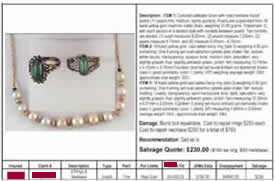What Can You Learn from Salvage?
What’s it worth? What can I do with it now?
And even: Was the settlement the most cost-effective solution?
A partial loss is too often a missed opportunity. When a stone is lost or chipped, when jewelry is damaged, when one of a pair of earrings goes missing, insurers may simply replace the piece, paying out the full limit of liability.
That damaged jewelry should always be inspected. A thorough examination frequently discloses details about quality, inherent flaws, and condition of the surviving piece that lead to more cost-effective solutions than full replacement.
Recently a carrier contacted JCRS to evaluate its salvage. We found that in most cases the settlement resulted in overpayment. In 9 of the 19 claims, the adjuster was led to believe something that was not true.
In some cases, jewelers advised that repair was not an option. In others, a jeweler was not even consulted. A few examples:
| These rings and necklace
were burnt in a fire. The insurer paid out $5,600. The repair would have cost $760. Insurer’s overpayment: $4,840. |
 |
 |
The onyx center stone is missing from the ring. The carrier paid out the full policy limit of $1,500, but the stone could have been replaced for one tenth that amount. Insurer’s overpayment: $1,350 |
What’s left over after a partial loss holds many clues for saving on settlements. With a total loss, you have no choice but to work from the appraisal and other documents. But with a partial loss, always have the damaged jewelry inspected. Ask for a detailed description of the remaining jewelry, and compare this description with the appraisal.
FOR AGENTS & UNDERWRITING
In your review of loss files, use salvage as a measure for appraisal accuracy. If the description of the damaged piece does not match the description on the original appraisal, this may indicate that appraisals on the policyholder’s other scheduled jewelry are equally inaccurate and unreliable. If so, this is a good time to recommend that the other jewelry be appraised by a qualified appraiser, such as a Certified Insurance Appraiser™ in jewelry.
FOR CLAIMS
Always have damaged jewelry inspected. Ask for not just a repair estimate but also for a detailed description of the remaining jewelry, and compare this description with the appraisal. Such a comparison may reveal a value far below the insured valuation.
Do not automatically go to the original selling jeweler for assessment of damage. Remember he is in the business of selling (rather than repairing) jewelry. If he knows you’ve chosen him to either repair or replace, he will most likely recommend replacement.
With salvage jewelry, get quotes from several jewelers before selling. Jewelers
often expect insurers to be easy marks in this area (see May
2000 IM NEWS) and may take advantage of your lack of jewelry knowledge.
©2000-2025, JCRS Inland Marine Solutions, Inc. All Rights Reserved. www.jcrs.com



